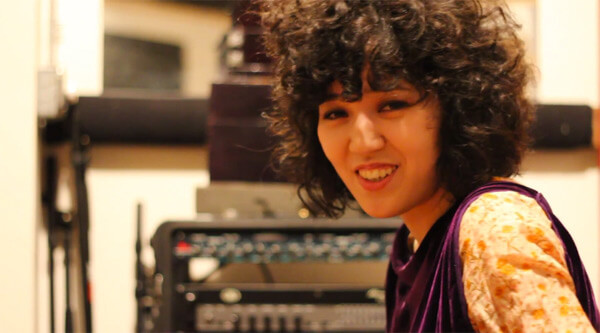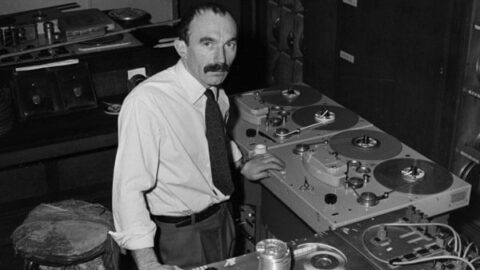
Britannia House, a large building just off Brick Lane in London’s East End, used to be a carpet factory. March 20-23, 2014, it was the trendy host to the London Contemporary Music Festival’s retrospective of the works of Bernard Parmegiani, an obscure but very cool experimental composer who died last year. In October, Britannia House will become a large commercial block of offices and “cultural events” called Second Home. If anyone ever asks you to define the term “gentrification,” you could maybe pay a visit.

It was an excellent space for LCMF’s retrospective: Parmegiani seems to suit such unconventional surroundings well. A student of Pierre Schaeffer’s who originally trained as a mime artist with Jacques Lecoq, Parmegiani mostly wrote electronic music, somewhat after the musique concrète style of Schaeffer himself. I made it to the first three of the four evenings, sampling a number of electronic works, one for electronics and violin, a few of his soundtracks along with their films, and a couple of sets from contemporary electronic musicians inspired by Parmegiani. I came away convinced that Parmegiani’s neglect has been undeserved—though I can’t help wondering how many similar electronic composers there are out there about whom I might have felt the same.
The biggest, most emblematic piece came on Friday night: La creation du monde is a 73-minute-long blue whale of a piece, dating from the early 1980s. It’s as epic as its title implies, cast in three movements of symphonic proportions entitled “Black Light,” “Metamorphosis of the Void,” and “Signs of Life.” It was undeniably hard work, but there was something compelling about it as well—it was clear all weekend, in fact, that Parmegiani paid keen attention to how to shape his works dramatically. This was far from the random sequence of unrelated screeches and bleeps that one might assume. Each movement was carefully, lovingly shaped, and calling it a symphony isn’t a grandiose claim—with a slow, ethereal slow movement and frenetic, pensive outer ones, this is clearly how the piece was conceived. Memorable moments abounded, from the slow, epic plod of the opening to the strange menagerie heard at the start of the final movement, but it wasn’t just the moments that impressed, but the graceful sweep of the whole.
The shorter electronic pieces were just as compelling: La roue Ferris (1971) and Pour en finir avec le pouvoir d’Orphée (1972) both confirmed him as an electronic composer with a particularly deft touch for the dramatic—no doubt nurtured by his substantial involvement with film. And, indeed, his soundtracks were equally impressive, and a very suitable backing for some short films just as experimental and strange as his music.
There were also films, all from the 1960s, by Peter Foldes, Piotr Kamler, Jan Lenica and Walerian Borowczyk: all eastern European filmmakers who, it seems, mixed weirdness and humor in equal measure. Lenica’s A, for instance, sees a crudely animated gentleman tormented by a large and mysterious letter A; Kamler’s L’araignéléphant (The Spiderelephant) tells the curious tale of its titular creature, who only ever goes in one direction. Borowczyk’s Les jeux des anges is a more seriously-inclined piece, which was spoken of with great respect by Daniel Bird, who introduced the films. I found it slightly opaque. Here is The Spiderelephant instead.
What the films all shared, of course, was Parmegiani, and it’s hard to imagine any of them having the impact they did without such prominent sound—in the more abstract shorts, the sound was on a more or less equal footing to the visuals, and in the narrative ones, Parmegiani’s obviously keen sense of the absurd served him well. It’s easy to imagine that all of this early work with film was what enabled Parmegiani to structure his abstract compositions so cogently—but that doesn’t seem to be quite right, given that his most brilliant composition predated almost all of the soundtracks. Violostries, from 1964, is a piece for violin and tape, given a dream performance from festival co-curator Aisha Orazbayeva. As gripping an electroacoustic piece as I’ve heard, it deserves far more frequent performances. You can judge for yourself, as she’s generously put an earlier live performance on her Soundcloud page.
Live sets from electronic musicians Rashad Becker and Vessel amply demonstrated Parmegiani’s skill yet further, illustrating the sort of annoying, pretentious mess that music in this medium can so easily become. But while I’m now convinced as to Parmegiani’s skill, there seems a strong chance that it’s not just him who deserves attention—Parmegiani was a member of the Groupe de Recherches Musicales, a collective which grew out of the original musique concrète movement, and with which Xenakis was also involved. I wonder how many other composers from this group deserve a reappraisal today, when we’ve all become a bit more used to the idea of electroacoustic composition—how about François-Bernard Mâche, for example, who is still alive? Even Schaeffer himself, after all, is a figure much more read-about than listened-to today—perhaps all of this music needs a retrospective, and not just Parmegiani.

But this was certainly a welcome introduction to an underappreciated figure. The LCMF team (that’s Igor Toronyi-Lalic, Lucy Railton and Sam Mackay as well as Orazbayeva) deserve much credit for putting it all together, and so do the many musicians credited with diffusing the sound around the performing space—Diana Salazar, Aki Pasoulas, Ambrose Seddon, Peiman Khosravi, Denis Smalley and Jonty Harrison (the biggest job, La création du monde, was handled by the last two). I missed out on hearing Daniel Teruggi’s diffusion chops on the final night, too—as well as a set from Florian Hecker.
Though organised by the same team, this was not itself the London Contemporary Music Festival 2014. That will come later on this year, with programme and venue yet to be announced. Last year’s inaugural festival was free; the Parmegiani events weren’t (apart from the first night)—but impressively, people still came. This festival seems to have found its niche already, and its future looks bright. I have no idea where they will take their audience next, which is part of the excitement.
























